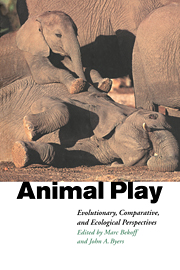Book contents
- Frontmatter
- Contents
- List of contributors
- Introduction
- 1 The evolutionary origins of play revisited: lessons from turtles
- 2 Play in common ravens (Corvus corax)
- 3 Object play by adult animals
- 4 Kangaroos at play: play behaviour in the Macropodoidea
- 5 Intentional communication and social play: how and why animals negotiate and agree to play
- 6 Structure-function interface in the analysis of play fighting
- 7 Sparring as play in young pronghorn males
- 8 Squirrel monkey play fighting: making the case for a cognitive training function for play
- 9 Self assessment in juvenile play
- 10 Biological effects of locomotor play: getting into shape, or something more specific?
- 11 Neurobiological sustrates of play behavior: glimpses into the structure and function of mammalian playfulness
- 12 Play as an organizing principle: clinical evidence and personal observations
- Index
9 - Self assessment in juvenile play
Published online by Cambridge University Press: 20 November 2009
- Frontmatter
- Contents
- List of contributors
- Introduction
- 1 The evolutionary origins of play revisited: lessons from turtles
- 2 Play in common ravens (Corvus corax)
- 3 Object play by adult animals
- 4 Kangaroos at play: play behaviour in the Macropodoidea
- 5 Intentional communication and social play: how and why animals negotiate and agree to play
- 6 Structure-function interface in the analysis of play fighting
- 7 Sparring as play in young pronghorn males
- 8 Squirrel monkey play fighting: making the case for a cognitive training function for play
- 9 Self assessment in juvenile play
- 10 Biological effects of locomotor play: getting into shape, or something more specific?
- 11 Neurobiological sustrates of play behavior: glimpses into the structure and function of mammalian playfulness
- 12 Play as an organizing principle: clinical evidence and personal observations
- Index
Summary
Introduction
Many young mammals play and we still do not really understand why. The play literature abounds with hypotheses and speculation (Fagen 1981, Smith 1982, Baldwin 1986, Martin & Caro 1985), but quantitative support for most functional hypotheses is in frustratingly short supply. There is a wealth of descriptive data, but most of it deals with very basic and superficial aspects of play, such as sex differences in play frequency and the resemblance between play and serious fighting on a very gross level. Studies of play rarely have a strong theoretical underpinning. Undoubtedly, part of the problem results from the lack of precisely worded, falsifiable hypotheses (Caro 1988, Byers & Walker 1995). Compounding this is a tendency for certain ideas to become generally accepted, despite the lack of strong supporting data (e.g., that play is rehearsal for adult behaviors or serves to strengthen social bonds between playmates).
Some of the strongest recent play research addresses topics that are tangential to the function of play, for example the metabolic and fitness costs of play (Caro 1988, 1995; Miller & Byers 1991; Siviy & Atrens 1992) and the relationship between play and perturbations in the social environment such as decreased maternal responsiveness and the onset of weaning (Bateson et al. 1990, Smith 1991, Moore & Power 1992, Terranova & Laviola 1995). There is a need for carefully formulated hypotheses that generate testable predictions and detailed, quantitative data that are directly relevant to tests of these predictions.
In this paper, I will briefly consider several aspects of play that seem inadequately explained by current theory.
- Type
- Chapter
- Information
- Animal PlayEvolutionary, Comparative and Ecological Perspectives, pp. 183 - 204Publisher: Cambridge University PressPrint publication year: 1998
- 48
- Cited by

